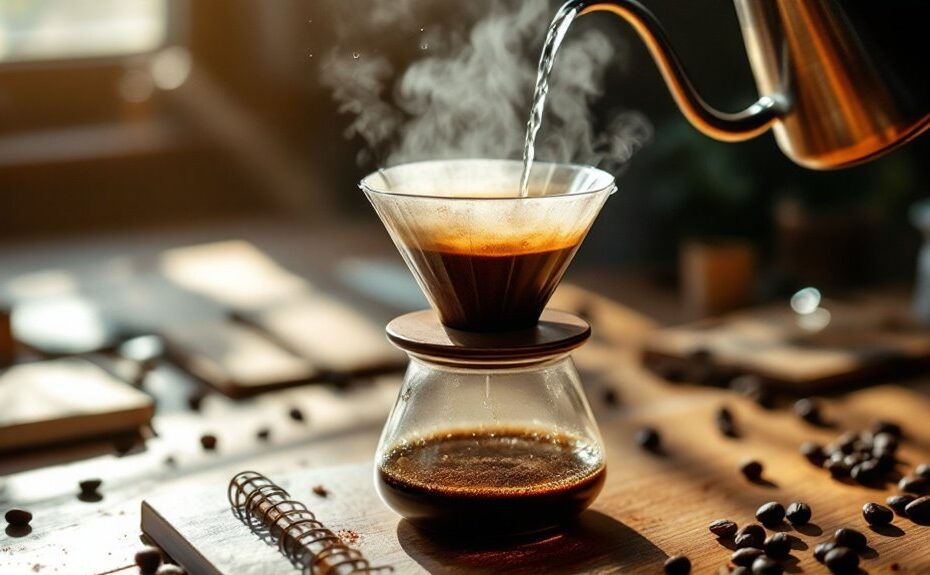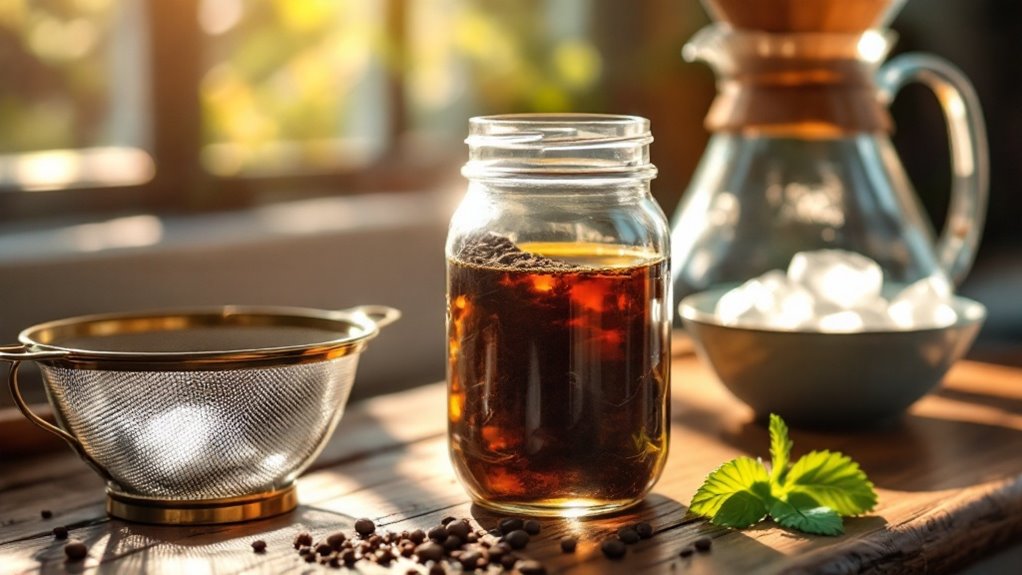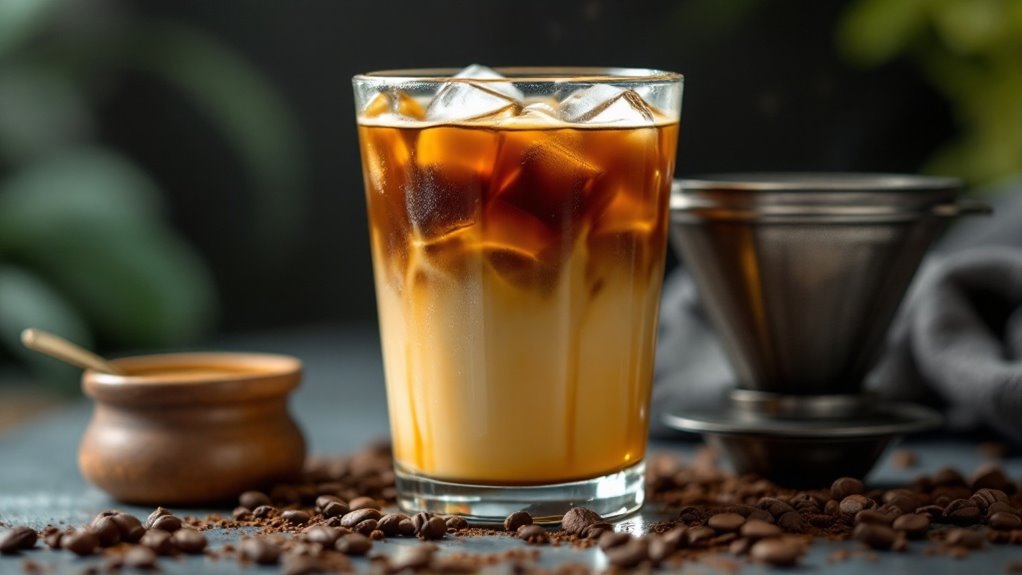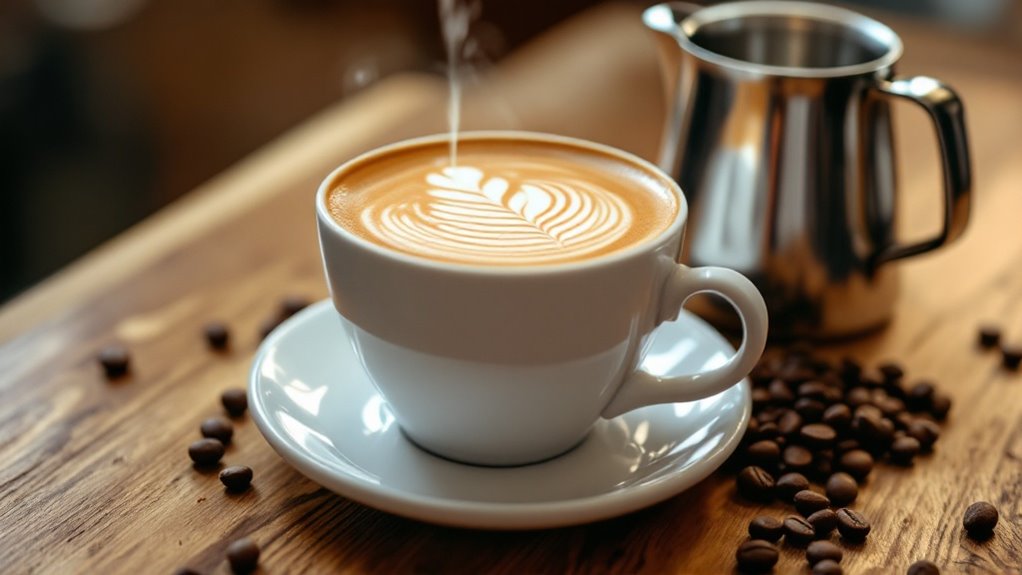







Making pour-over coffee at home might seem simple, but the details matter. You'll need freshly roasted beans, a gooseneck kettle, and the right grind size to start. The process involves precise water temperature, a careful bloom, and a steady pour, but even small adjustments can drastically change the flavor. What if your brew tastes too bitter or weak? The answer lies in understanding the balance between grind size, water ratio, and timing. There's more to uncover about perfecting your technique—and it starts with the basics. What's the first step you're missing?
Key Takeaways
- Use freshly ground, high-quality coffee beans and a medium-coarse grind size for optimal flavor and extraction.
- Heat water to 195°F–205°F and maintain a 1:15 to 1:17 coffee-to-water ratio for balanced brewing.
- Rinse the paper filter with hot water to remove residue and preheat the dripper before adding coffee grounds.
- Start with a 30-45 second bloom phase, then pour water in slow, circular motions for even saturation and extraction.
- Aim for a total brew time of 3-4 minutes, adjusting grind size or pour speed if extraction is too fast or slow.
Choosing the Right Coffee Beans
To make exceptional pour-over coffee, you'll need to start with high-quality, freshly roasted coffee beans. Opt for single-origin beans to explore distinct flavor profiles, such as the fruity notes of Ethiopian beans or the chocolatey tones of Colombian varieties. Light to medium roasts are ideal for pour-over methods, as they highlight nuanced flavors without introducing excessive bitterness. Always choose freshly roasted coffee beans, ideally within two weeks of their roast date, to guarantee peak aroma and taste. Avoid pre-ground coffee; instead, grind your beans just before brewing to preserve their freshness and prevent flavor degradation. Experiment with different bean origins and roast levels to discover the flavor profiles that best align with your preferences, securing a consistently satisfying cup of quality coffee.
Essential Equipment for Pour-Over Coffee
Once you've selected your coffee beans, the next step is gathering the right tools to brew a perfect pour-over. Start with a gooseneck kettle, which provides precise control over water flow for even saturation. A burr grinder guarantees a consistent medium-coarse grind, essential for ideal extraction. Choose a pour-over dripper, such as a Chemex or Hario V60, to hold the coffee grounds and filter. Pair your dripper with high-quality paper filters to remove sediment and achieve a clean cup. Finally, use a digital scale to measure coffee and water accurately, maintaining a 1:15 to 1:17 coffee-to-water ratio. These tools—gooseneck kettle, burr grinder, dripper, and filters—are indispensable for mastering the pour-over method and brewing a balanced, flavorful coffee.
Grinding Coffee to the Perfect Consistency
When grinding coffee for pour-over, aim for a consistency similar to fine sea salt, as this guarantees even extraction and balanced flavor. Use a burr grinder to achieve a uniform grind size, making certain each particle extracts at the same rate. Inconsistent grind sizes can lead to over-extraction of fine particles and under-extraction of coarse ones, resulting in a muddy or weak brew. Adjust the grind size coarser if your coffee tastes bitter, as bitterness often signals over-extraction. Freshly ground coffee is vital—grind just before brewing to preserve its aroma, which diminishes rapidly after grinding. Experiment with grind size to fine-tune your brew, aiming for a total extraction time of 3-4 minutes. This precision makes certain a clean, flavorful cup every time.
Preparing the Filter and Coffee Grounds
Start by selecting a cone-type coffee filter and rinsing it with hot water to eliminate any paper residue. Measure 2 heaping tablespoons of freshly ground coffee per 6 ounces of water, ensuring a balanced coffee-to-water ratio. Place the rinsed filter securely in your pour-over funnel or stand, then evenly distribute the measured coffee grounds inside.
Choosing the Right Filter
To guarantee a clean and flavorful cup of pour-over coffee, selecting the right filter is essential. Start by choosing a high-quality paper filter, such as Chemex filters, which are designed to eliminate sediment and deliver a clean brew. Rinse the filter with hot water to remove any paper taste and preheat your brewing vessel. For eco-friendly alternatives, consider reusable metal filters or hemp filters, though they may allow more sediment into your cup. Make sure the filter fits snugly in your pour-over cone to prevent grounds from bypassing during brewing. Once rinsed, place the filter in the cone and prepare to add your coffee grounds. The right filter guarantees ideal extraction and a balanced flavor profile in every pour.
Measuring Coffee Grounds
After preparing your filter, the next step is measuring your coffee grounds accurately. Use a kitchen scale to guarantee precision, as consistency is key to a balanced brew. Start by placing your pour-over dripper on the scale and tare it to zero. Add 25g of medium-coarse coffee grounds, resembling fine sea salt, for ideal extraction. This measurement aligns with a 1:15 coffee-to-water ratio, meaning you'll pair it with 375g of water. The scale guarantees you maintain this ratio, which is critical for achieving the desired flavor profile. Once measured, distribute the coffee grounds evenly in the pre-wetted filter. Avoid eyeballing measurements, as even slight deviations can impact the final taste. Precision at this stage sets the foundation for a well-extracted, flavorful cup.
Mastering the Pouring Technique
While mastering the pouring technique is essential for achieving a balanced pour-over, it begins with controlling the flow of water using a gooseneck kettle. Start by pouring hot water in a slow, steady stream, moving in a circular motion from the center outward to evenly saturate the coffee grounds. Begin with a bloom phase: pour just enough water (about 60g for 20g of coffee) to wet the grounds, then wait 30-45 seconds for CO2 to escape. Divide the remaining water into two or three equal pours, maintaining a consistent flow and circular motion. Swirl gently after each pour to guarantee even extraction and prevent dry pockets. Keep the water level just below the filter rim to avoid over-saturation and guarantee proper drainage during the drawdown phase. Aim for a total brew time of 3-4 minutes.
Understanding Water Temperature and Ratios
Start by heating your water to 195°F–205°F, adjusting slightly based on roast level—lighter roasts benefit from hotter water, while darker roasts perform better at the lower end. Use a coffee-to-water ratio of 1:15 to 1:17, measuring 2 heaping tablespoons of coffee per 6 ounces of water for a standard cup. If your brew tastes weak, increase the coffee or water temperature; if it's bitter, reduce the coffee or lower the temperature slightly.
Optimal Water Temperature Range
To achieve the best flavor in your pour-over coffee, maintaining the ideal water temperature range of 195°F to 205°F is critical. This range guarantees proper extraction, balancing acidity and sweetness while avoiding bitterness. Heat your water to just below boiling (around 200°F) and let it cool slightly before pouring over coffee grounds. Water below 195°F may under-extract, leaving your brew weak or sour, while temperatures above 205°F risk over-extraction, creating a bitter or burnt taste. Use a gooseneck kettle for precise control when pouring water over coffee grounds, guaranteeing even saturation. Consistent water temperature throughout the brewing process is key to revealing the full potential of your pour-over coffee. Avoid letting the water cool too much between pours to maintain ideal extraction.
Coffee-to-Water Ratio Basics
The coffee-to-water ratio is a fundamental factor in crafting a balanced pour-over brew, working in tandem with water temperature to influence extraction. Start by using a 1:15 ratio—1 gram of coffee grounds to 15 grams of water—for a standard cup. Measure your coffee and water precisely using a scale to guarantee consistency. For example, 20 grams of coffee grounds require 300 grams of water. Adjust the ratio slightly to 1:16 or 1:17 for a lighter brew or 1:14 for a stronger flavor, but avoid drastic changes. Always use fresh coffee grounds and filtered water heated to 195°F–205°F. This precise approach guarantees ideal extraction, balancing acidity, sweetness, and bitterness for a refined pour-over experience.
Adjusting Ratios for Flavor
When adjusting your coffee-to-water ratio for flavor, it's essential to take into account how water temperature interacts with extraction. Start with a ratio of 1:15 to 1:17 (1 gram of coffee to 15-17 grams of water) for a balanced flavor. Use a scale to measure water and coffee by weight for precision. For a stronger brew, tighten the ratio to 1:14, or go to 1:18 for a lighter, more delicate flavor. Pair your ratio with the right water temperature: aim for 195°F to 205°F, with lighter roasts benefiting from higher temperatures (closer to 205°F) and darker roasts performing better at lower temperatures (around 195°F). This guarantees ideal extraction and avoids bitterness or under-extraction.
Adjusting Brew Time for Optimal Flavor
While achieving the perfect pour-over coffee, adjusting brew time is essential for extracting ideal flavor. Aim for a total brew time of 2:45-3:30 minutes to achieve a balanced flavor profile. Start by splitting your pours into two or three stages, which helps control extraction levels and optimize brew time. Monitor the drawdown time; if it's too slow, your grind size may be too fine, leading to over-extraction. Conversely, if the brew time is too short, adjust your grind size finer to slow extraction. Experiment with gentle agitation, like swirling the slurry, to fine-tune extraction and brew time. By carefully managing these variables, you'll make pour-over coffee with consistent, balanced flavor and avoid under- or over-extraction.
Troubleshooting Common Pour-Over Issues
If your pour-over coffee isn't meeting expectations, identifying and addressing common issues can substantially improve your brew. If the coffee tastes weak, make sure your grounds are fine enough to increase extraction. For bitter coffee, coarsen the grind or reduce brewing time to prevent over-extraction. Uneven extraction often occurs when pouring water too quickly; use a gooseneck kettle to slowly pour in a controlled spiral motion. Sediment in your cup may result from a too-coarse grind or a damaged filter; switch to paper filters for a cleaner draw. If your brew time exceeds 4 minutes, your grind might be too fine, causing clogging; adjust to a slightly coarser grind. These adjustments guarantee your coffee is made with precision and balance.
Exploring Sustainable Brewing Practices
To make your pour-over coffee routine more sustainable, start by replacing disposable paper filters with reusable metal or cloth alternatives, which substantially reduce waste. Compost used coffee grounds and paper filters to enrich soil, supporting eco-friendly gardening. Opt for ethically sourced, shade-grown beans to promote biodiversity and reduce deforestation. Use filtered water to enhance flavor and minimize impurities, ensuring a perfect cup every time. Invest in a durable pour-over setup to avoid frequent replacements, reducing long-term waste. Support local coffee roasters who prioritize sustainable farming and fair trade practices, as they often make great coffee with minimal environmental impact. By choosing local coffee and visiting coffee shops that align with these values, you'll make coffee that's both delicious and environmentally responsible.
Disclosure: As an Amazon Associate, I earn from qualifying purchases.







